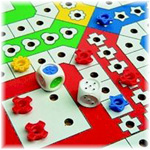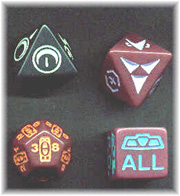Throw the Dice!
Input: standard input
Output: standard output
Time Limit: 30 seconds
Memory Limit: 32 MB
In the pictures below, you can see several types of Dices. It is very
easy to assume that they are used in many different types of games. In this problem,
the face of the dices will be like those on the first figure, that means each
will have some dots it each face, which will indicate the value of that
particular face. But the looks of the dices will be like those on the second
figure, that means each dice may have 2,
3, 4, 5 up to 50 different
faces. A dice with p faces have face
values 1, 2, 3 … p. When a
dice is thrown all the faces are equally likely to come on top. For example an
ordinary dice in figure-1 has face values 1,
2, 3, 4, 5, 6 and the probability that face with value 1 will be on top is 1/6.
The same is the probability for the other faces coming on top.
 |
 |
| Figure 1: Two conventional dices | Figure 2: Dices of different shape |
The situation becomes complicated when you throw a dice more than once
dice. For example when you throw a dice twice, for any arbitrary incident the
summation of the top two faces can be within the range (inclusive) 2...12. But their probability is not equally
likely or 1/12. The probability that
the sum will be two is 1/36, but the
probability that some will be three is 2/36
and so on. Given the description of a dice throw, that’s how many faces
it have, how many throws will be made and value for the sum, you will have to
find the probability of obtaining that sum.
The input will contain several lines of input. Each line contains three integers F (The number of faces of the dice thrown, 1<=F<=50), N (The number of throws and 0<=N<=50) and S (The summation value for which you to find out the probability, 0<S<=4000).
For each line of input you will have to produce one line of output which will be of the form a/b (Here b = FN). Here a/b means the probability value. Note that we don’t need the floating point value of probability.
6 2 2
6 2 3
6 3 10
1/36
2/36
27/216
(World Final Warm-up Contest, Problem setter: Shahriar
Manzoor)
“He He!!! Why
does this guy like probability so much? :-)”